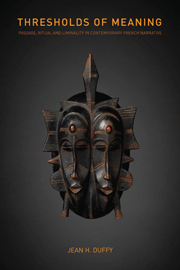Book contents
- Frontmatter
- Contents
- Acknowledgements
- List of illustrations
- Introduction
- 1 At death's door: illness, ritual and liminality in Darrieussecq, Lenoir, and Mauvignier
- 2 Suicide and saving face in Bon, Mauvignier and Bergounioux
- 3 Commemoration, monument and identity in Bergounioux, Darrieussecq and Rouaud
- 4 Retouching the past: family photographs and documents in Rouaud, Bon and Lenoir
- Conclusion: Writing passage and the passage to writing
- Notes
- Select bibliography
- Index
2 - Suicide and saving face in Bon, Mauvignier and Bergounioux
- Frontmatter
- Contents
- Acknowledgements
- List of illustrations
- Introduction
- 1 At death's door: illness, ritual and liminality in Darrieussecq, Lenoir, and Mauvignier
- 2 Suicide and saving face in Bon, Mauvignier and Bergounioux
- 3 Commemoration, monument and identity in Bergounioux, Darrieussecq and Rouaud
- 4 Retouching the past: family photographs and documents in Rouaud, Bon and Lenoir
- Conclusion: Writing passage and the passage to writing
- Notes
- Select bibliography
- Index
Summary
Among acts by individuals that challenge social and religious norms, suicide ranks among the most transgressive. The part played by religion and, in particular, Christianity in the stigmatisation of the act of self-destruction and the individual who kills or attempts to kill himself/herself has, of course, been rehearsed on countless occasions. As Georges Minois points out in his overview of the history of suicide, the early Christian Church seemed to give out mixed messages on the question: the earthly life is a vale of tears and the Christian should aspire to death so that he/she can be united with God and granted eternal life, but death must not be sought out of despair:
La vie est haïssable, mais il faut la supporter; la mort est souhaitable, mais il ne faut pas se la donner: tel est le difficile exercice sur lequel doit reposer la vie chrétienne. Les enseignements essentiels, tels qu'on les trouve dans le Nouveau Testament et tels qu'ils seront développés par les courants de spiritualité, créent un contexte qui prédispose à la mort volontaire. Il faudra toute l'habileté théologique des penseurs chrétiens, appuyée sur des mesures canoniques dissuasives, pour créer une morale affirmant l'interdiction du suicide.
(Minois, 1995, 36)- Type
- Chapter
- Information
- Thresholds of MeaningPassage, Ritual and Liminality in Contemporary French Narrative, pp. 72 - 130Publisher: Liverpool University PressPrint publication year: 2011

